
6 - Jazz chords
In this chapter you will get some useful information about jazz chords.
- Jazz chord notation
- Chord view in Djangolizer
- Creating alternative chords
- Chord extensions
- Chord Substitutes
- Chord view in Djangolizer
- Creating alternative chords
- Chord extensions
- Chord Substitutes
Jazz chord notation
Unfortunately, there is no international notation for chords. There are different systems and symbols for the extensions of chords.Below is a table with the most common chord notations. In the green fields, you see the notation how it's shown in Djangolizer.
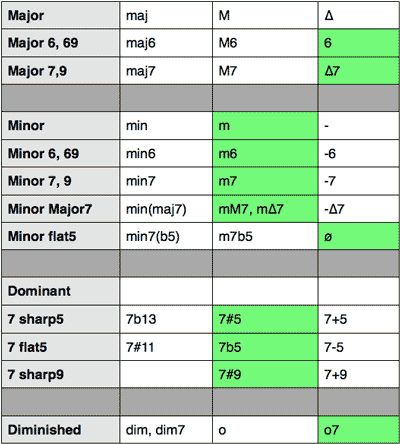
Chord view in Djangolizer
Activate "Chord" and "Full Fretboard", to get the view of the two most common grips of each chord.


In this example you can see the two common grips for C major.
Of course there are many more possibilities to grab a chord.
Djangolizer shows you one chord per each of the five positions.
Chord table for printing out
Download a Gypsy Swing chord table and print it out for having it handy…Jazz Manouche Chords.pdf
Jazz chords are moveable over the fretboard!
You should know at least all the notes on the E- and A-string, to have the chance to grab chords in all tonalities.
Find alternative chords
To find out other possibilities to grab chords, turn on the "arpeggio" and "Full Fretboard" view. All that matters is, that the chord is easy to grab and sounds good in combination with the previous and the next chord.The two notes you can leave out are the root note (1) and the fifth (5), without loosing the gender or "face" of the chord.
Especially when you play with a bass player, which mainly plays those two notes, you can leave them out without any problem.
Be aware, that the highest note of a chord sticks out and dominates the other notes.
Here, three alternatives for grabbing an E7 chord…
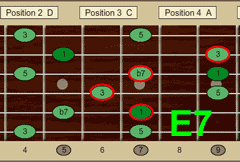
Here, the brightest tone is the third.
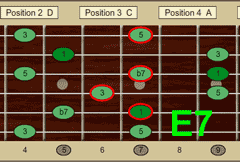
The sound of fifth dominates this chord.
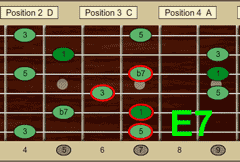
Here, the dominant 7th note sticks out.
To grab the notes 1 and 5, use just your middle finger for both of them.
Here are three examples, how you can play an E9 chord, by adding or leaving out some notes.
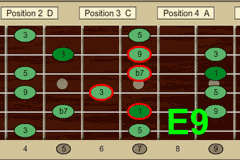
Here, the ninth sticks out.
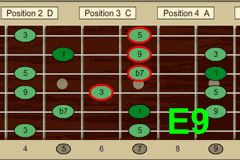
Here, the fifth dominates the sound of the chord.
For the notes 5, 9 and b7, make a bridge with your ring finger.
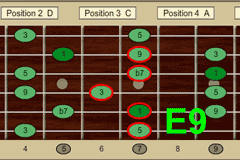
To grab the notes 1 and 5, use just your middle finger for both of them.
Chord extensions
If you play a dominant chord as an E7 or an E9 is a matter of taste. The E9 sounds more modern and is used more in a major correlation.And it doesn't really matter, if you play a major chord as a triad or with extensions as maj7, maj9, 6 or 69.
But it is a question about the chord sounds cool and is easy to grab after the chord before.
Some chord extensions are also very typical for each music style as Swing, Waltz, BolÚro or Bossa.
Djangolizer Power-User
The exercise "Ex - Chord extensions - Major mode" will show you some examples of chord extensions correlated to the different music styles.Substitutes
Diminished Chords
An E7 chord can be substituted by a diminished chord like the Fdim7.The F dim7 chord has the same notes as G# dim7, B dim7 and D dim7, but in another order. These four chords are exchangeable.
There are three groups of exchangeable diminished chords…
Group #1: F░ - G#░ - B░ - D░
Group #2: F#░ - A░ - C░ - D#░
Group #3: G░ - A#░ - C#░ - E░
Djangolizer Power-User
You will find a variety of chord combinations with diminished chords in the exercise"Ex - Diminished Chords".
Another example with diminished chords is in the song "Minor Swing - exercises" at bars 33-48.
Choose the "Arpeggio" and "Full Fretboard" view, to compare the notes.
Tritonus Substitute
You can add some flavour to a dominant chord, without changing his harmony behaviour.The dominant 7th chords can be substituted by another dominant 7th chord. The distance of these two chords must be a tritonus.
For example…
Instead of an A7, you could play an Eb7, or instead of a D7, play an Ab7.
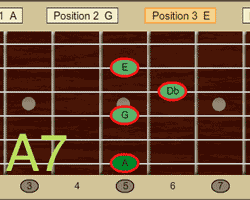
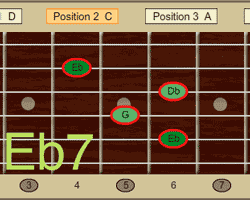
Of course, that principle is not only meant for substituting chords, but also for soloing.
Try to play an Eb7 arpeggio over an A7 chord. How does this sound to you?



